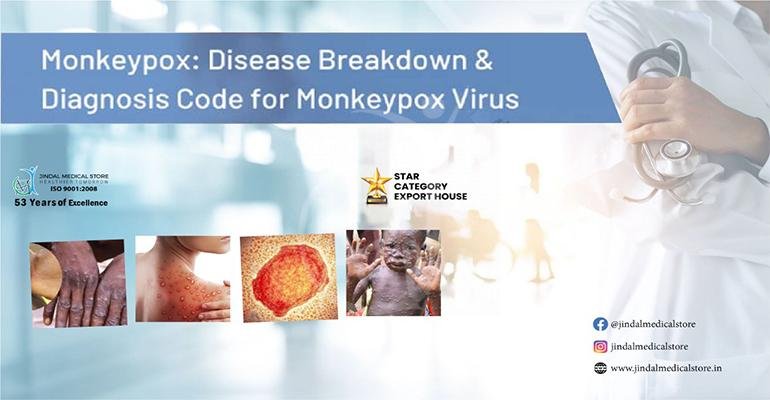What Should You Know About Monkey Pox?

Cases of Monkey Pox in India: What Should You Know About It?
The world is still trying to overcome the difficult times of COVID-19, and we have a new problem staring at our faces. As per WHO, the cases of Monkey Pox are rising globally. So, the next question that pops up is where the world is heading to another pandemic and whether we should worry about it.
Well, precaution is always better than cure. WHO has already declared Monkey Pox as an emergency health situation. On 29th July 2022, WHO reported that there were around 18,000 cases of Monkey Pox outside Africa. In India, around 4 cases of Monkey Pox have been reported. Let’s unfold more details on Monkey Pox.
More on Monkey Pox
It is a rare viral infection initially reported in parts of Central and West Africa. The disease was first reported in animals, but in the last 50 years, it has also spread to humans. The disease has been spreading at a rapid pace in recent times. An important point to note about the Monkey Pox is that it spreads only with close contact. Only physical contact with the patient suffering from Monkey Poxes makes this disease spread.
This contact can be through broken skin, nose, mouth, or eyes. Hence, as a result, a person who comes in contact with lesions or body fluids, or respiratory droplets of the infected patient can get a Monkey Pox.
People who are immunocompromised can also get severely impacted by Monkey Pox. Usually, this disease is self-limiting, and the infected person recovers within a week or two. Sometimes it may take around a month to completely recover from this disease. However, Monkey Pox is more severe in the case of young children and pregnant women.
Common symptoms of Monkey Pox:
The disease starts showing symptoms between 6 to 13 days of contact with the infected person. Common symptoms of Monkey Pox include:
- Rash development similar to that of chickenpox
- A fever follows the rash
- The infected person can experience chill and headaches
- Some of the other symptoms include exhaustion, sore throat, swollen lymph nodes (particularly around the neck, groin, chin, and armpits),
- Initially, the symptoms were mild. However, the swelling and lesions can be painful and itchy. These symptoms start subsidizing within 14-21 days.
Knowing about the Monkey Pox and its key symptoms is paramount. Since this disease is spreading and around 18,000 people have been infected globally, it is important to know its symptoms and probable causes.
The European region has witnessed a skyrocketing rise in the number of Monkey Pox cases. So what has caused this outbreak? Usually, the Monkey Pox disease was reported in Central and Western Africa. However, the disease has recently spread to parts of Europe and slowly towards Asia. Although Monkey Pox is said to spread by close physical contact, there have been cases where people have got this disease even when they have no travel history or link to an area where people suffer from Monkey Pox.
The geographically dispersed nature of the case across the region and beyond is causing the spread of diseases which went undetected. And now, the cases are becoming more prominently visible.
Types of Monkey Pox virus:
Add two types of Monkey Pox virus, one that originated in western Africa and the other is the Congo basin type. Most of the cases that have been recently reported belong to the western African type of monkey virus. These are milder and usually self-limiting. Also, there is a lesser probability of death due to this disease.
Monkey Pox Case Updates Till 28th July 2022
The cases of monkey pops are on a highrise, and every day you can hear some news about this disease. Recently around four cases were reported in India as well. Here is a brief overview of the status of Monkey Pox cases:
| Country | Cases |
| Spain | 3738 |
| Germany | 2459 |
| France | 1827 |
| Netherlands | 879 |
| Portugal | 588 |
| Italy | 426 |
| Belgium | 393 |
| Austria | 118 |
| Ireland | 85 |
| Sweden | 81 |
| Denmark | 71 |
| Poland | 53 |
| Norway | 50 |
| Hungary | 37 |
| Slovenia | 33 |
| Greece | 32 |
| Luxembourg | 23 |
| Romania | 20 |
| Finland | 17 |
| Malta | 17 |
| Czechia | 16 |
| Croatia | 11 |
| Iceland | 9 |
| Slovakia | 6 |
| Western Balkan Countries | 6 |
| Estonia | 5 |
| Bulgaria | 4 |
| India | 4 |
| Latvia | 3 |
| Turkey | 1 |
Monkey Pox in India
Around six days back, the first case of Monkey Pox was reported in India, and the tally reached four. The cases are still under study to report and understand what has caused or triggered the disease in India.
What should people do in case they suspect Monkey Pox infection?
We have already highlighted the key symptoms of Monkey Pox infection. Presently there is no vaccine or medicine for this disease. If you notice or suspect that you might have this disease, you should take the necessary precautions and connect with your health care service provider for further assistance.
You must contact your doctor in the following cases:
- Notice unusual rash or lesion
- Do not touch the rash or the lesion
- Wash the bedding and belongings of the infected person, and other people should not use them.
- Wash your hands regularly
- Do not come in close physical contact or sexual contact with the infected person
- Affected persons should be isolated until the symptoms are resolved
Kids, pregnant women, and immunocompromised individuals should be kept from the infected person. These people have a higher probability of catching the infection.
Preventive measures to prevent the spread of Monkey Pox:
Since there is no vaccination for this disease, it is important to follow the necessary precautionary measures to prevent the spread of this infection. Here are some of the important steps that you can follow:
- Avoid skin-to-skin or face-to-face contact with the infected person
- Practice safer (s-e-x)
- Washing your hands regularly
- Meet the doctor in case you notice unusual lesions or swelling
What’s next?
Since the infection spreads fast, it is important to closely observe symptoms and follow a healthier lifestyle and eating habits. In addition, the pharmaceutical companies in India are working to explore more on this disease and find a probable cure. Similar to the pandemic times, when India came to the front to supply medicine and medical aid, it would follow suit. JMS (Jindal Medical Store) is a leading name ensuring a seamless supply of medicine across different nations. In addition, it is also spreading awareness about this disease that can help people take necessary precautions.



Comments
Post a Comment